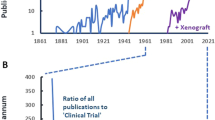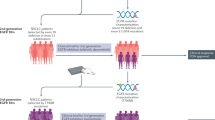Abstract
The high price of many innovative drugs, which is in part due to the considerable expense and risk involved in drug development, underlines the need for more efficient approaches to bring drugs to the market, with more effective translational research in particular identified as an important part of such strategies. Here, the development of the cancer drug bortezomib (Velcade; Millennium Pharmaceuticals) by a biotechnology company — Myogenics/ProScript — started by academics from Harvard University is discussed to dissect the key academia–industry/public sector–private sector interactions that made the development of this drug a success despite many barriers. A model to explain how and why bortezomib was approved in record time is presented, and areas for public-policy initiatives to improve translational research in general are highlighted.
This is a preview of subscription content, access via your institution
Access options
Subscribe to this journal
Receive 12 print issues and online access
$209.00 per year
only $17.42 per issue
Buy this article
- Purchase on Springer Link
- Instant access to full article PDF
Prices may be subject to local taxes which are calculated during checkout


Similar content being viewed by others
References
von Eschenbach, A. C. A vision for the National Cancer Program in the United States. Nature Rev. Cancer 4, 820–828 (2004).
AAAS Report XXX. Research & Development FY 2006 [online], <http://www.aaas.org/spp/rd/rd06main> Intersociety Group. American Association for the Advancement of Science. Part II, Chapter 8, TABLE II-9 (2005).
Brower, V. The squeaky wheel gets the grease. EMBO Reports 6, 1014–1017 (2005).
Monga, M. & Sausville, E. A. Developmental therapeutics program at the NCI: molecular target and drug discovery process. Leukemia 16, 520–526 (2002).
Mowery, D. C., Nelson, R. R., Sampat, B. N. & Ziedonis, A. A. Ivory Tower and Industrial Innovation: University–Industry Technology Transfer before and after the Bayh–Dole Act. (Stanford Univ. Press, Stanford, 2004).
Ciechanover, A. Proteolysis: from the lysosome to ubiquitin and the proteasome. Nature Rev. Mol. Cell Biology 1, 79–87 (2005).
Hershko, A. & Ciechanover, A. The ubiquitin system. Annu. Rev. Biochem. 67, 425–479 (1998).
Adams, J. The proteasome: a suitable anti-neoplastic target. Nature Rev. Cancer 4, 349–360 (2004).
Palombella, V. J., Rando, O. J., Goldberg, A. L. & Maniatis, T. The ubiquitin-proteasome pathway is required for processing the NF-κB 1 precursor protein and the activation of NF-κB. Cell 78, 773–785 (1994).
Adams, J. Development of the proteasome inhibitor PS-341. The Oncologist 7, 7–16 (2002).
Richardson, P. G. et al. A phase 2 study of bortezomib in relapsed, refractory myeloma. N. Engl. J. Med. 348, 2609–2617 (2003).
Richardson, P. G. et al. Bortezomib or high-dose dexamethasone for relapsed multiple myeloma. N. Engl. J. Med. 348, 2487–2498 (2005).
Goldberg, A. in Cancer Drug Discovery and Development: Proteasome Inhibitors in Cancer. (ed. Adams, J.) 17–38 (Humana, Totowa, 2004).
Stein, R. L., Ma, Y. T. & Brand, S. Inhibitors of the 26s proteolytic complex and the 20s proteasome contained therein. US Patent 5,693, 617 (1995).
Adams, J. et al. Boronic ester and acid compounds. US Patent 5,780, 554 (1995).
Barnes, P. J. & Karin, M. Nuclear factor-κB: a pivotal transcription factor in chronic inflammatory diseases. N. Engl. J. Med. 336, 1066–1071 (1997).
Teicher, B. A., Aran, G., Herbest, R., Palombella, V. J. & Adams, J. The proteasome inhibitor PS-341 in cancer therapy. Clin. Cancer Res. 5, 2638–2645 (1999).
Palombella, V. J. et al. Role of the proteasome and NF-κB in streptococcal cell wall-induced polyarthritis. Proc. Natl Acad. Sci. USA 95, 15671–15676 (1998).
Adams, J. et al. Proteasome inhibitors: a novel class of potent and effective anti-tumor agents. Cancer Res. 59, 2615–2622 (1999).
Orlowski, R. et al. Phase I trial of the proteasome inhibitor PS-341 in patients with refractory hematologic malignancies. J. Clin. Oncol. 20, 4420–4427 (2002).
Bioline [online], <http://www.massbio.org/pubs/Bioline_v12_n3.pdf> (2005).
Langreth, R. & Moukheiber, Z. Medical merlins. p5 Forbes (23 June 2003).
Pharmaceutical Research and Manufacturers of America (PhRMA). Pharmaceutical Industry Profile 2005 — From Laboratory to Patient: Pathways to Biopharmaceutical Innovation [online], <http://www.phrma.org/publications/publications//2005-03-17.1143.pdf> (Washington DC, 2005).
Sánchez-Serrano, I. Academia–Biotech Spin-Offs: What is inside the Black-Box? Translational Research and Academia–Industry Collaborations in the Process of Drug Development. (Thesis, Tufts Univ. and Massachusetts Inst. Technol., 2004).
Solow, R. M. A contribution to the theory of economic growth. Q. J. Econ. 70, 65–94 (1956).
Acknowledgements
This research was co-sponsored by the Organization of American States (OAS) through the Panamá Permanent OAS Diplomatic Mission, Washington DC, USA. The author thanks F. Murray for guidance on his graduate thesis and P. Elliott, N. Demirdöven and D. Morand for their critical reading of this manuscript and their constructive suggestions.
Author information
Authors and Affiliations
Ethics declarations
Competing interests
The author declares no competing financial interests.
Supplementary information
Related links
Rights and permissions
About this article
Cite this article
Sánchez-Serrano, I. Success in translational research: lessons from the development of bortezomib. Nat Rev Drug Discov 5, 107–114 (2006). https://doi.org/10.1038/nrd1959
Issue Date:
DOI: https://doi.org/10.1038/nrd1959
This article is cited by
-
Pharmacokinetic aspects of the clinically used proteasome inhibitor drugs and efforts toward nanoparticulate delivery systems
Journal of Pharmaceutical Investigation (2021)
-
Bortezomib for the Treatment of Hematologic Malignancies: 15 Years Later
Drugs in R&D (2019)
-
Clinical Pharmacokinetics and Pharmacodynamics of Bortezomib
Clinical Pharmacokinetics (2019)
-
USP24 induces IL-6 in tumor-associated microenvironment by stabilizing p300 and β-TrCP and promotes cancer malignancy
Nature Communications (2018)
-
On the road from classical to modern molecular biology
Nature Medicine (2012)



